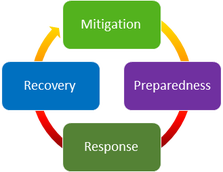PLANS
Pacific County Emergency Management Agency
Tsunami Evacuation Maps
During a distant source tsunami event, Pacific County Emergency Management officials may recommend that residents evacuate by one or more of several methods. The Pacific County Emergency Notification Network is a telephonic warning system that will dial county residents through the public switched telephone network. A recorded message will provide residents the information pertinent to the event. In addition, a message will be broadcast over NOAA weather radio. Pacific County fire departments and districts will also be dispatched to broadcast a message via truck mounted PA systems when time allows. View Pacific County evacuation maps by clicking below:
Ocean Park to Leadbetter State Park
Hazard Mitigation Plan (HMP)
Understanding this cycle is the first step in effectively planning and operating in relation to all disaster related activities. The emergency management cycle is an open ended and ongoing process. The four phases in the process are mitigation, preparedness, response, and recovery. Each phase of the cycle can last years or moments in length while different paths can exist simultaneously.

Mitigation planning is the process of determining how to reduce or eliminate the loss of life and property damage resulting from natural and human-caused hazards. It is carried out as any sustained action to reduce or eliminate long-term risk to life and property from a hazard event. Mitigation encourages long-term reduction of hazard vulnerability. As is the goal of emergency management, the goal of mitigation is to save lives and reduce property damage.
The purpose of the Pacific County Hazard Mitigation Plan is to provide guidance to substantially and permanently reduce Pacific County and its communities’ vulnerability to natural and technological hazards. The Pacific County Hazard Mitigation Plan was first written in 2010, revised in 2015, and again in 2021. These revisions are twofold in their purpose. These plan revisions encompass the continuation and updating of the plan’s original mission as well as the incorporation of new GIS technologies, improved risk assessment methodologies, and additional best-practices. PCEMA has just submitted its newest iteration Hazard Mitigation Plan to FEMA for approval. That plan is available for viewing below as a DRAFT. The plan is intended to promote sound public policy designed to protect citizens, critical facilities, infrastructure, private property, and the natural environment. This will be achieved by increasing public awareness and education, documenting resources for risk reduction and loss-prevention, and identifying and prioritizing activities and strategies guiding the community towards the development of a safer, more sustainable community.
Once the revised plan is approved by FEMA, it will be formally adopted by each of the twenty-nine community stakeholders who are named in the plan. Hazard Mitigation Plan Revision is a continuous process. The next iteration of the Pacific County Hazard Mitigation Plan will be submitted to FEMA for approval in 2027.
Comprehensive Emergency Management Plan (CEMP)
A primary function of emergency management involves Preparedness. Preparedness not only encompasses training and educating residents and citizens of the county, but also the act of engaging and educating emergency management partner agencies. PCEMA partner agencies meet on a continual basis to prepare and in doing so, document that level of preparedness through written plans. An example of this is the Pacific County Comprehensive Emergency Management Plan (CEMP). The CEMP is an overarching emergency management document that corroborates that process of engagement among all partner agencies. The CEMP is made up of a basic plan, followed by several Emergency Support Function (ESF) sections. Every other month, PCEMA facilitates a meeting to discuss either basic portions of the plan or an ESF, with the relevant partners. That section of the plan is reviewed, revisions are made/suggested and once every four years, all revisions are then rolled up and submitted to Washington State Emergency Management. The process is fairly typical of most of the plans linked below. The public is always welcome and encouraged to attend a meeting and comment as well. In addition, any and all submitted written comments are incorporated and considered during the bi-monthly reviews.
The Pacific County Emergency Management Agency will gladly email any plan referenced within either the CEMP or HMP upon request.
COMMUNITY WILDFIRE PROTECTION PLAN (CWPP)
The Pacific County Emergency Management Agency, in cooperation with local fire departments, landowners, community partners, Washington State Department of Natural Resources, Washington State Parks, and the US Fish and Wildlife Service, are working with Bintel Inc. to develop a Community Wildfire Protection Plan.
A CWPP is a comprehensive plan developed by local citizens and state and federal agencies. These protection plans are based on the needs of the people in the community and can address issues such as wildfire response, hazard mitigation, community preparedness, structure protection or all of the above.
What is included in a CWPP?
- Fire history, behavior, & probability
- Firefighting capabilities & water supplies
- Evacuation routes
- Wildfire community hazard ratings
- Wildfire mitigation recommendations
- Home ignition zone recommendations
We welcome you to visit our Community Wildfire Protection Plan page where you can find the plan, maps, and other information.

